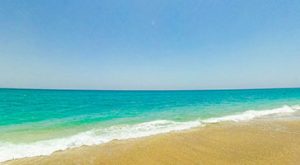By: Jon Berry

Many onlookers see kiteboarders ripping waves or sending huge jumps and immediately say to themselves, “Looks fun, but I could never do that.” The purpose of this article is to debunk that myth.
Following are some quick facts about learning to kiteboard that, we hope, will allow you to realize that pretty much anyone can do it. Including you.
Who can kiteboard?
Eligible students range from young kids (minimum weight is 70lbs, age is not a factor) to people in their 70s. Males, females and kids can pick up the sport easily. People with back and knee problems sometimes have trouble but we have generally been able to find a workaround to allow them to kite comfortably.
Do you have to be strong to kiteboard?
No. An inflatable kite attaches to you using a waist harness with a metal hook on it that takes the majority of the load off your hands. Flying a kite efficiently means you are using just your fingertips to steer, totally relaxed, cruising along, leaning into your harness. Significant strength is not required.
Is kiteboarding dangerous?
It can be. That is why we take pride in our teaching methodology. Knowing your safety systems cold, knowing how to spot safe or unsafe wind directions, and knowing how to identify accidents before they happen is what makes you a true “kiteboarder”. We pride ourselves on ensuring you are well rounded and knowledgeable before you go out.
Can I teach myself or learn from a friend?
We do not recommend it. Like driving a car or learning to ski, learning to kite requires respect and learning a calculated risk. We equate it to slapping on a pair of skis and heading to your favorite black diamond on your first day out. There are core competencies and skill sets that clients must master before being capable of going out safely. We recommend learning from a professional.
Is kiteboarding expensive?
The upfront costs certainly are. But we view it as an investment that pays off and becomes economic over time. After you have learned the sport properly, invested in gear, and are self-sufficient the wind is free and the water is free. You’re never buying a lift ticket and you can kite all over the world at minimal cost with your whole family.
Do you have to be in-shape?
No, but it helps. Whether you are perfectly skinny or have a little cushion in the middle, modern kiteboard equipment is suited for all body types. Tiny harnesses and tiny boards and big harnesses and big boards allow small kids to large adults to ride. Our job is to make sure you are setup with the right equipment and pace you appropriately to prevent fatigue.
What background helps?
Kiteboarding brings together two core skills: Flying a kite and riding a board. Any experience on the water like sailing, windsurfing, boating and having a basic understanding of the wind will help your learning curve. Most importantly, any board experience like snowboarding, skateboarding, and particularly wakeboarding, will translate to your kiteboarding. Regardless, zero or little experience with the above does not preclude you from learning to kiteboard.
How can I prepare for my lesson?
The most basic element of learning to kiteboard is kite control. Trainer kites cost very little (Feel free to order through us!) and are safe to use with no prior experience. Find a friend, head to the beach and spend a few days learning to fly your trainer kite to the point where you can fly it with your eyes closed. While not mandatory, it will dramatically accelerate your learning curve. Practice wakeboarding is a big plus too.
The bottom line is that learning to kiteboard should not be difficult or strenuous and pretty much anyone can do it. When taught properly the process is incremental and intuitive and allows you to truly understand how a kite works. The result is to create a self-sufficient kiteboarder capable of going out safely and coming back safely with their gear and their body intact. And having the time of their life as they do it.
If you have any questions or are interested in coming out for a lesson, please do not hesitate to email us at desk@nlwatersports or give us a call at 508-680-3343.
Hope to see you on the water soon!
NLW Pro Tip – When you first fly a kite and figure out the basics of the “Wind Window” you will learn about the “Power Zone”. Learning how to control a kite to generate appropriate power is one of the core competencies to being able to put a board on your feet. Make your life easy and check out this video which does a great job of breaking down the basics. We hope it will familiarize you with some of the lingo and accelerate your learning curve!






